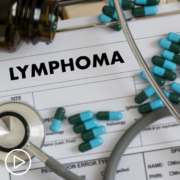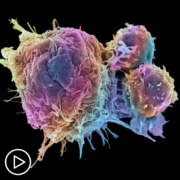Omidubicel (Expanded Cord Blood) for use in Allogeneic Transplant
Introduction
Umbilical Cord Blood (UCB) has been used as a source of stem cells in allogeneic (donor) transplants since the late 1980s. When doing a transplant using bone marrow (BM) or peripheral blood (PB), it is necessary to have a close Human Leukocyte Antigen (HL) type match to reduce the chance of the transplant being rejected and the risk of Graft-Versus-Host Disease (GVHD). Since UCB contains more naïve cells, it does not need to match nearly as well to be used as a source of stem cells in a transplant. This is important for people who do not have good unrelated donor matches in the registries, in particular minorities who tend to be underrepresented in the registries and people of mixed race.
Since a single UCB unit contains significantly fewer stem cells than a PB or BM graft, it takes longer for a patient’s white blood (neutrophil) count and platelet count to recover when getting a UCB transplant. This is a fundamental problem of using UCB for transplants. This means that patients are at risk of infections for a longer time. There have been a number of attempts to expand the number of cells in a cord blood unit, dating back at least 20 years, but none have managed to be approved by the U.S. Food and Drug Administration (FDA).
FDA Approval
The FDA approved omidubicel to reduce time to neutrophil recovery in April, 2023. This was based on a Phase 3 randomized study (reported in Omidubicel vs standard myeloablative umbilical cord blood transplantation: results of a phase 3 randomized study) that compared the outcome of patients who received omidubicel versus those who underwent conventional cord blood transplants.
Comparison of Omidubicel and standard Cord Blood transplants
The trial enrolled 125 patients who were randomly assigned to receive omidubicel (62 patients) or a standard UCB transplant (63). Patients in the standard transplant arm received a double cord transplant if the initial CB unit was not well matched or contained a smaller number of cells. 67% of those patients received a double cord transplant, 33% a single cord transplant. Three alternative myeloablative conditioning regimens were allowed and different regimens to prevent GVHD.
The time to white blood cell recovery (a neutrophils count of at least 500) and platelet recovery (a count of at least 20) was much faster in patients who received omidubicel. Patients who received omidubicel had neutrophil recovery a median of 10 days faster than patients who received a standard UCB. Platelet recovery was a median of 13 days faster for those receiving omidubicel. Patients who received omidubicel spent a median of 11 fewer days in the hospital in the first 100 days post-transplant and experienced fewer serious infections..
There are a couple of drawbacks to omidubicel. About 10% of the CB units had manufacturing or production failure. In addition, it takes about 21 days to manufacture omidubicel. These issues resulted 14% of patients not being able to receive the therapy.
Discussion
Omidubicel is a significant advance in the use of cord blood for transplants. There was a big reduction in hospital stays and infections. There may be a survival benefit with omidubicel., the study was too small to determine if there was a statistically significant increase in survival, although there seemed to be a trend toward better survival. The authors of the paper in Blood , state: “The results suggest that omidubicel may be considered as a new standard of care for adult patients eligible for UCBT”. I think this probably is an understatement and centers that use cord blood in adults and older children will rapidly start using omidubicel. No doubt there will be a high price for omidubicel, but this is likely to be balanced out by reduced number of days in the hospital.
A major question that remains unanswered is how omidubicel will now compare to transplants using an unrelated donor or a half-matched family member (haploidentical). My guess is that most centers that do not do cord blood transplants in adults will continue to use unrelated or haploidentical donors. Probably, in a few years there will be a comparison done, at least using data from transplant registries.
I asked Karen Ballen, M.D. Chief, Hematology/Oncology, University of Virginia Cancer Center for comment on omidubicel (I would also like to thank her for graciously providing comments on this article):
Omidubicel is the first product approved by the FDA for expansion of a stem cell transplant graft, in this case cord blood. The randomized clinical trial showed an advantage in neutrophil and platelet engraftment and days in the hospital. There was no survival benefit, which could potentially limit use. The cost of the product is unknown. Another drawback is the 2.5 to 3 weeks needed to manufacture. Nonetheless, this represents a major advance in the cell therapy field.
Further Reading
- FDA OKs Stem Cell Therapy to Reduce Infection Risk in Blood Cancer Patients
- FDA approves omidubicel to reduce time to neutrophil recovery and infection in patients with hematologic malignancies, FDA announcement.
- FDA Approves Omidubicel-onlv for Hematologic Malignancies, from CancerNetwork.
- Omidubicel vs standard myeloablative umbilical cord blood transplantation: results of a phase 3 randomized study from Blood (2021) 138 (16): 1429–1440.
- Cord blood expansion has arrived, commentary on the Blood article, by Elizabeth J. Shpall and Katayoun Rezvani

AML Network Manager
Art Flatau lives in Austin, Texas with his wife Gretchen. They have 2 grown children. He was diagnosed with Acute Myeloid Leukemia (AML) in 1992 at the age of 31, while still in graduate school at the University of Texas. Gretchen and Art’s kids were 2 and 4 at the time. He received chemotherapy (both induction chemotherapy and then consolidation). After graduating with a Ph.D. in computer science in December 1992. He relapsed in early 1993 and then had a bone marrow transplant (BMT), his brother was a perfect match.






